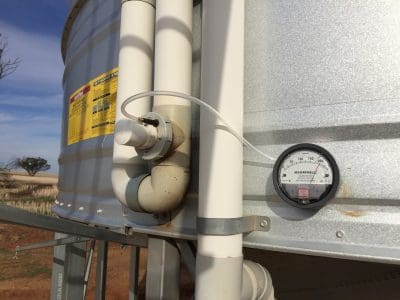THE INSTALLATION of phosphine monitoring devices at sample stands, and warnings about Queensland penalties for misuse, have seen a significant reduction in incidents where phosphine gas was detected in deliveries to GrainCorp this year.
This is in contrast to 2016, when off-label uses of phosphine were suspected following GrainCorp testing which showed several deliveries of grain from on-farm storages had unacceptably high levels of phosphine.
This prompted GrainCorp to post an alert in May last year, which stated that transporting grain fumigated with phosphine where the detectable level of gas was greater than or equal to 0.3 parts per million (ppm) was illegal.
The introduction of phosphine monitors allows for the routine testing of all loads prior to receival into the GrainCorp system.
Since the 2016 detections, GrainCorp has recorded no major incidents, thanks to what appears to be increased vigilance about phosphine levels, and better awareness about the dangers of levels of phosphine that exceed health standards.
Breaches policed
While a minor breach could be explained as inattention, Grain Central understands that the most severe incident would register a gas concentration in the grain many hundreds of times the 0.3 ppm threshold, possibly caused by illegal use of phosphine pellets at the point of on-farm loading, releasing gas while the truck was in transit.
The Queensland Department of Agriculture and Fisheries (DAF) said grain handling companies typically monitored the concentration of phosphine in bulk grain on arrival at their facilities and might notify an authority.
“A number of Queensland Government departments, including DAF, have been voluntarily notified of rejected loads. These notifications trigger a risk assessment for potential breaches under the Chemical Usage (Agricultural and Veterinary) Control Act 1988,” a DAF spokesperson said.
The maximum penalty for using registered agricultural products, including phosphine, in contravention of the label is 600 penalty units, currently $73,140.
DAF reminds all users of agricultural and veterinary chemical products they must be aware of their legal responsibilities and the need for responsible and safe use.
Effective use of phosphine
Phosphine gas is used to kill stored grain pests. It is a poisonous gas which can kill humans. A label of a product containing phosphine is marked “dangerous poison, group 24A insecticide”; the chemicals are subject to Australian Pest and Veterinary Medicines Authority (APVMA) approval.
Grower management of stored grain has improved in recent years thanks to increased on-farm use of gas-tight silos, advances in control systems and venting.
Non-label usage of farm chemicals remains an issue for the grain supply chain, domestic and export. Fumigants — including phosphine — are an ongoing topic for the National Working Party on Grain Protection, and will be discussed at the 2017 Australian Grain Storage and Protection Conference in Melbourne on June 7-8.
GRDC fumigation guide: https://grdc.com.au/Resources/Factsheets/2014/01/Grain-Fumigation-guide




HAVE YOUR SAY